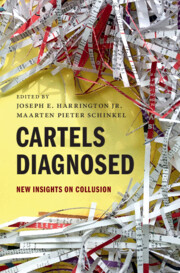Book contents
- Cartels Diagnosed
- Cartels Diagnosed
- Copyright page
- Contents
- Figures
- Tables
- Contributors
- Introduction
- 1 Entry Barriers, Personal Relationships, and Cartel Formation
- 2 “Now You Are Asking for a Real War!”
- 3 Coordinating Fuel Surcharges
- 4 Price Fixing or Fixing Competition?
- 5 The Role of Platforms for Facilitating Anticompetitive Communication
- 6 Collusion with Non-express Communication
- 7 Cartel Instability and Price Wars
- 8 Coordinated Rebate Reductions and Semi-collusion
- 9 Average Bid Auction Format Facilitates Bidding Rings
- 10 The Challenges of Cartelization with Many Products and Ongoing Technological Advancements
- 11 Two Cartels in the Supply Chain
- 12 Is it Collusion or Competition behind Price Parallelism?
- References
12 - Is it Collusion or Competition behind Price Parallelism?
Steel Manufacturing in Greece*
Published online by Cambridge University Press: 06 December 2024
- Cartels Diagnosed
- Cartels Diagnosed
- Copyright page
- Contents
- Figures
- Tables
- Contributors
- Introduction
- 1 Entry Barriers, Personal Relationships, and Cartel Formation
- 2 “Now You Are Asking for a Real War!”
- 3 Coordinating Fuel Surcharges
- 4 Price Fixing or Fixing Competition?
- 5 The Role of Platforms for Facilitating Anticompetitive Communication
- 6 Collusion with Non-express Communication
- 7 Cartel Instability and Price Wars
- 8 Coordinated Rebate Reductions and Semi-collusion
- 9 Average Bid Auction Format Facilitates Bidding Rings
- 10 The Challenges of Cartelization with Many Products and Ongoing Technological Advancements
- 11 Two Cartels in the Supply Chain
- 12 Is it Collusion or Competition behind Price Parallelism?
- References
Summary
◦ Not all parallel price increases are the result of unlawful coordination and could as well be the product of competition. The case study of the steel industry in Greece reminds us of this important fact and, in doing so, provides a rigorous analysis to distinguish competition from collusion.
◦ In the steel market in Greece, there was some striking evidence of price parallelism whereby the three main producers changed their prices more or less simultaneously. In response, the Hellenic Competition Commission pursued an investigation to determine if they were colluding, either explicitly or tacitly.
◦ In spite of the suspicious patterns, the evidence put forth in the case study supports competition. It is explained how common price movements are likely the result of common information. Every morning, all three suppliers had available to them international and regional price levels for each product type. This information allowed them to determine the maximum price that a Greek producer would be able to sell in the domestic market given the prices that Greek importers could purchase steel from other countries. This import price acted as a reference price which was common knowledge to all Greek producers and drove changes in the competitive domestic list prices.
◦ Complementing this argument with a rich empirical analysis, the case study concludes the observed price patterns are likely explained as an outcome of competitive behavior.
- Type
- Chapter
- Information
- Cartels DiagnosedNew Insights on Collusion, pp. 342 - 373Publisher: Cambridge University PressPrint publication year: 2025

